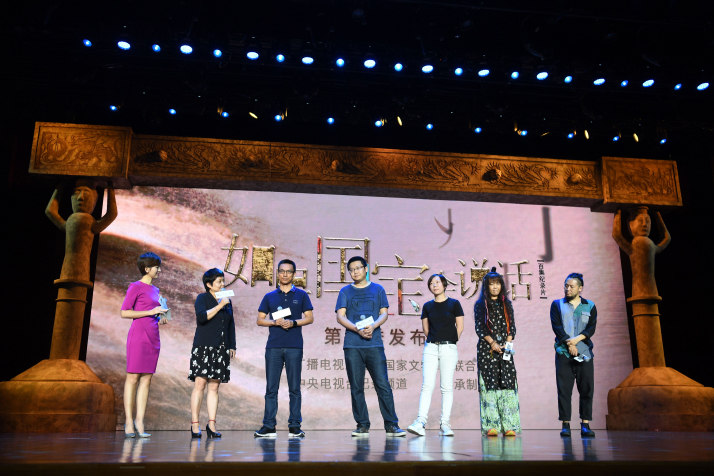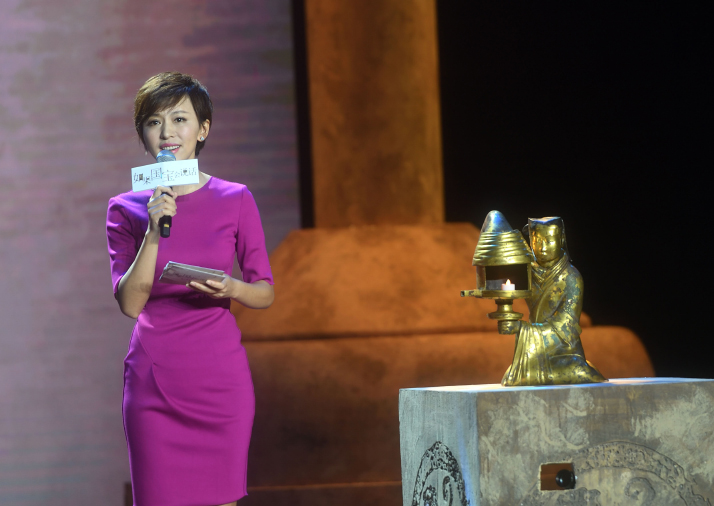| Lifestyle |
| Treasure Talks | |
| Innovative methods facilitate the spread of traditional culture among China’s youth | |
|
|
 Chief director of cultural variety show Every Treasure Tells a Story Xu Huan (second left) attends the launch ceremony of the show's second season in Beijing on July 13
Innovative methods facilitate the spread of traditional culture among China's youth By Ji Jing The second season of the cultural variety show Every Treasure Tells a Story recently aired on China Central Television (CCTV) and video streaming websites Iqiyi.com, V.qq.com and Bilibili.com. Compared with the first season which hit screens at the beginning of the year and primarily focused on pottery, jade ware and bronze vessels, the latest offering incorporates a wider variety of treasures such as bamboo and wooden slips, lacquerware, and stone carvings to reflect the development of production from the Warring States period (453-221 B.C.) to the Qin and Han dynasties (221 B.C.- A.D. 220).  CCTV presenter Ouyang Xiadan hosts the launch ceremony for the second season of Every Treasure Tells a Story
Lively presentation The show consists of 25 five-minute episodes, with each installment featuring an individual item of such historical import that it is considered a national treasure. In contrast to traditionally staid and protracted history-themed documentaries, Every Treasure Tells a Story adopts a direct and light-hearted approach to depicting historical artifacts. Each episode starts with a voiceover declaring that "You have a message from national treasure, please check." On video streaming sites, hundreds of audience responses pepper the bullet screen— a phenomenon whereby real-time comments from viewers fly across the screen like bullets—with the same missive: "Message received." According to Xu Huan, chief director of the show, in the past before the advent of streaming sites, it was impossible to understand the reception to a show in such an immediate way. In the second episode, which looks at a bronze vessel of the Warring States period, digital animation is used to restore the aged bottle to its original state and to reenact the scenes of war inscribed on its surface. The war is brought to life in vivid detail, portraying one-on-one combat between two soldiers, while others fall from city walls, and another scene of decapitation. The third episode focuses on a famous set of chime bells from 433 B.C., unearthed from the tomb of Marquis Yi in central China's Hubei Province in 1978, and showcases a piece of music played using the ancient instrument and recorded in 1986. Awed by the music, one netizen's post shoots across the bullet screen on Iqiyi.com, "This is marvelous! I am almost moved to tears." Every Treasure Tells a Story has a score of 9.7 out of 10 on popular review site Douban.com, surpassing the 9.5 rating for its first season. The series is co-produced by CCTV and the State Administration of Cultural Heritage (SACH). "We want to prove that in addition to being serious, culture can also be lively and interesting," said Xu. "Although Internet users nowadays are easily attracted by amusing and superficial content, they are also willing to learn about culture if it is presented in an entertaining way," she added. "The show revolutionizes a genre previously dominated by lengthy documentaries and is very suitable for new media platforms and mobile terminals," said Gu Yucai, Deputy Director of SACH. The five-minute format suits the pace of modern life and satisfies the preference of modern audiences for fragmented content. However, it challenged the production team to complete a comprehensive introduction to such illustrious objects in just five minutes. According to Xu, a lot of research needed to be undertaken first in order to make a single episode. "Our team consulted a number of historical documents," said Xu. "We also invited experts from the School of Archaeology and Museology at Peking University and other institutions to give us advice. We wrote several versions for each episode and chose the best one to use, which is one of the reasons why our scripts have been well-received by our audience." Her team consists of over 20 scriptwriters, producers, directors and experts in archaeology, museology and anthropology. The show will take four seasons to showcase a total of 100 artifacts selected from over 3 million national treasures in more than 100 museums across the country. In order to ensure the authenticity of the show, all the objects on camera are originals instead of replicas. However, the artifacts are often fragile, as many of them are more than 2,000 years old. And the production team has to find ways to overcome manifold problems in order to present the original treasures while guaranteeing their preservation. "The objects that appear in the series have each had an important role to play in the formation and spread of Chinese civilization, or reflect the production and creativity of their time," said Xu. "As the public's cultural appreciation improves, they are paying more and more attention to cultural artifacts. Satisfying their needs by bringing cultural artifacts closer to ordinary people has become one of our top priorities. That is why the show was created," said Gu. A user account for the show was set up on social networking platform Sina Weibo, and the objects featured in the show were promoted on short video app Douyin, so as to enable Internet users to interact more closely with them. Singing scrolls Every Treasure Tells a Story is not the only attempt by Chinese creators to spread traditional culture in a more entertaining way. A recent competition titled Paintings Can Sing was launched by the Palace Museum, Tencent NEXT IDEA and QQ Music to encourage music lovers aged 17-35 to submit songs based on ancient paintings. The Palace Museum has authorized the use of 10 famous paintings from its collection as the source of inspiration for contestants, including the famous Song Dynasty (960-1279) paintings Along the River During the Qingming Festival and A Thousand Miles of Rivers and Mountains by artists Zhang Zeduan and Wang Ximeng, respectively. The top 10 entrants will get the opportunity to cooperate with famous singers and musicians to perform in concert at the Palace Museum. "It's a totally novel attempt by the Palace Museum and Tencent at cultural innovation. The event combines painting, music and technology and aims to enable young people to feel the beauty of traditional culture and represent classic paintings in a creative way," said Shan Jixiang, Curator of the Palace Museum. The theme music for the event is based on A Thousand Miles of Rivers and Mountains, one of China's most celebrated works of art, and is sung by Jackson Yee, a member of the popular Chinese boy band trio TFBOYS. "The best way to spread traditional culture is to bring it back to ordinary people, especially to young people's daily lives," said Cheng Wu, Vice President of Tencent Group. Copyedited by Laurence Coulton Comments to jijing@bjreview.com |
|
||||||||||||||||||||||||||||
|
